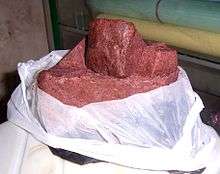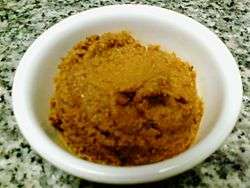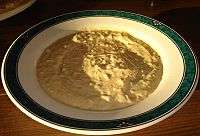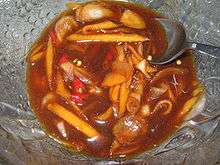List of food pastes

Korean denjang, a fermented bean paste
This is a list of notable food pastes. A food paste is a semi-liquid colloidal suspension, emulsion, or aggregation used in food preparation or eaten directly as a spread.[1] Pastes are often spicy or aromatic, prepared well in advance of actual usage, and are often made into a preserve for future use. Common pastes are curry pastes, fish pastes, some fruit preserves, legume pastes and nut pastes. Purées are food pastes made from already cooked ingredients, as in the case of cauliflower purée, or raw, as in the case of apple purée.
Food pastes
Fish and seafood

Lengkare shrimp paste in Lombok Island, Indonesia

A tub of uncured fish surimi ready for finish-processing
- Fish paste – prepared from fish parts through fermentation[2]
- Shrimp paste – made from fermented ground shrimp, either from fresh shrimp or dried ones, with the addition of salt. Prepared shrimp paste often has oil, sugar, garlic, chili, and other spices added.
- Surimi – refers to a paste made from fish or other meat and also refers to a number of Asian foods that use surimi as their primary ingredients
Fruit and vegetable
- Àmàlà – a Nigerian specialty paste made using yams, it is thick and brown
- Baba ghanoush – an eggplant (aubergine) based paste
- Date paste – used as a pastry filling
- Funge de bombo – a manioc paste used in northern Angola, and elsewhere in Africa
- Guava paste
- Hilbet – a paste made in Ethiopia and Eritrea from legumes, mainly lentils or faba beans, with garlic, ginger and spices.[5]
- Hummus – made from chickpeas with the addition of tahini, olive oil, lemon juice, salt and garlic.[6]
- Moretum
- Pesto
- Ssamjang – a Korean, sesame and bean based paste used as a sauce on meat
- Tapenade - made from olives ground with anchovies or capers, spices and olive oil
- Tomato paste – made from boiling tomatoes until they form a thick paste which is stored for later use in soups, sauces and stews.[7]
Grain
- Farina
- Millet paste – consumed by the Fula people in the Sahel and West Africa.[8] It is a main ingredient in nyiiri, a common Fula dish that is prepared using millet paste and a thick sauce.[8]
- Pamonha – a traditional Brazilian paste made from fresh corn and milk.
- Polenta
- Mealy pop or bogobe – prepared from ground grain usually maize or millet and often fermented before cooking.[9]
Instant soup
.jpg)
Erbswurst is a traditional instant pea soup from Germany in a consensed paste
- Erbswurst
Legume

A pancake filled with red bean paste
- Black bean paste
- Cheonggukjang
- Doubanjiang
- Doenjang
- Fermented bean paste – made from ground soybeans, which is then fermented
- Miso
- Mung bean paste
- Red bean paste
- Sweet bean paste
- Tauco
- Tương
- Yellow soybean paste
Meat

Pâté spread atop bread
- Chopped liver
- Pâté – finely chopped, finely ground or pureed highly seasoned meat, prepared using beef, pork, liver, or animal organs[10]
- Pheasant paste
- Potted meat food product
Nut and seed
- Almond butter
- Almond paste
- Cashew butter
- Lotus seed paste
- Marzipan – made from almonds, with the addition of sugar and sometimes egg whites,[11] it is used as a filling for confections, or hardened to serve as is.
- Peanut butter[12]
- Peanut paste – a product of peanuts and is used as an ingredient in sauces, baked goods and breakfast cereals, among others
- Plumpy'nut
- Satsivi
- Sunflower butter
- Tahini – made from ground sesame seeds,[13]
- Walnut paste – a Georgian specialty, it is used unsweetened as a bread dip, or sweetened as a filling in a baklava-like pastry
Spices and herbs
Herbs

Red kroeung paste
Spicy
Phanaeng curry paste is fried with coconut cream to make the curry more creamy in flavor
Sweet
- Cookie butter
- Fondant – a basic sugar paste used as an intermediary in the production of candies and icings.[14][15]
Yeast extracts

Marmite spread on toasted bread
Yeast extracts, usually as byproduct from brewing beer,[16] are made into food pastes, usually dark-brown in color.
See also
- Huff paste
- List of condiments
- List of dips
- List of spreads
- Mortar and pestle – a kitchen device used since ancient times to prepare ingredients or substances by crushing and grinding them into a fine paste or powder
- Wet grinder – a food preparation appliance used especially in Indian cuisine for grinding food grains to produce a paste or batter
References
- ↑ Kipfer, Barbara Ann (2012). The Culinarian: A Kitchen Desk Reference. New York: Wiley. p. 409. ISBN 978-1-118-11061-4.
- ↑ Lee, Cherl-Ho; Steinkraus, Keith H. & Reilly, P. J. (1993). Fish Fermentation Technology. New York: United Nations University Press. ISBN 978-89-7053-003-1.
- ↑ Saberi, Helen, ed. (2011). "Roman fish sauce. An experiment in archaeology". Cured, Smoked, and Fermented: Proceedings of the Oxford Symposium on Food. Prospect Books, Oxford Symposium, 2011. p. 121. ISBN 9781903018859.
- ↑ Curtis, Robert I. (1984) "Salted Fish Products in Ancient Medicine". Journal of the History of Medicine and Allied Sciences, XXXIX, 4:430-445.
- ↑ "Spaghetti silsie, or spicy fragrant tomato pasta sauce (Eritrea)". Vegventures. Archived from the original on 15 September 2012.
- ↑ Zubaida, Sami (2000). "National, Communal and Global Dimensions in Middle Eastern Food Cultures". In Zubaida, Sami; Tapper, Richard. A Taste of Thyme: Culinary Cultures of the Middle East. London: I.B. Tauris. p. 35. ISBN 978-1-86064-603-4.
- ↑ Kipfer 2012, p. 561
- 1 2 Regis, H.A. (2002). Fulbe Voices: Marriage, Islam, And Medicine In Northern Cameroon. Westview case studies in anthropology. Avalon Publishing. p. pt54. ISBN 978-0-8133-4706-6. Retrieved June 29, 2017.
- ↑ Akinrele, I. A. (2006). "Fermentation studies on maize during the preparation of a traditional african starch-cake food". Journal of the Science of Food and Agriculture. 21 (12): 619&ndash, 625. doi:10.1002/jsfa.2740211205.
- ↑ Kipfer 2012, p. 412
- ↑ Kipfer 2012, p. 354
- ↑ Russell 1995, p. 327
- ↑ McGee 2004, p. 514
- ↑ Kipfer 2012, p. 241
- ↑ Jones, David (2011). Candy Making For Dummies. New York: Wiley. pp. 65&ndash, 68. ISBN 978-1-118-05461-1.
- ↑ Sombutyanuchit, P.; Suphantharika, M.; Verduyn, C. (2001). "Preparation of 5′-GMP-rich yeast extracts from spent brewer's yeast". World Journal of Microbiology and Biotechnology. 17 (2): 163&ndash, 168. doi:10.1023/A:1016686504154.
External links




This article is issued from
Wikipedia.
The text is licensed under Creative Commons - Attribution - Sharealike.
Additional terms may apply for the media files.


